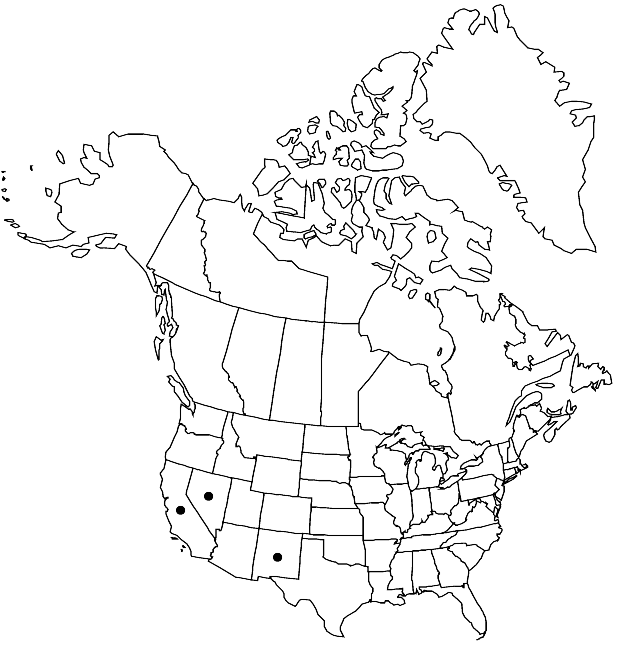Difference between revisions of "Cleomella obtusifolia"
in J. C. Frémont, Rep. Exped. Rocky Mts., 311. 1845.
FNA>Volume Importer |
imported>Volume Importer |
||
| (3 intermediate revisions by 2 users not shown) | |||
| Line 1: | Line 1: | ||
{{Treatment/ID | {{Treatment/ID | ||
|accepted_name=Cleomella obtusifolia | |accepted_name=Cleomella obtusifolia | ||
| − | |accepted_authority=Torrey & | + | |accepted_authority=Torrey & Frémont |
|publications={{Treatment/Publication | |publications={{Treatment/Publication | ||
|title=in J. C. Frémont, Rep. Exped. Rocky Mts., | |title=in J. C. Frémont, Rep. Exped. Rocky Mts., | ||
| Line 8: | Line 8: | ||
}} | }} | ||
|common_names=Mojave stinkweed | |common_names=Mojave stinkweed | ||
| + | |special_status={{Treatment/ID/Special_status | ||
| + | |code=E | ||
| + | |label=Endemic | ||
| + | }} | ||
|basionyms= | |basionyms= | ||
|synonyms={{Treatment/ID/Synonym | |synonyms={{Treatment/ID/Synonym | ||
|name=Cleomella obtusifolia var. florifera | |name=Cleomella obtusifolia var. florifera | ||
|authority=Crum ex Jepson | |authority=Crum ex Jepson | ||
| + | |rank=variety | ||
}} {{Treatment/ID/Synonym | }} {{Treatment/ID/Synonym | ||
|name=Cleomella obtusifolia var. jonesii | |name=Cleomella obtusifolia var. jonesii | ||
|authority=Crum ex Jepson | |authority=Crum ex Jepson | ||
| + | |rank=variety | ||
}} {{Treatment/ID/Synonym | }} {{Treatment/ID/Synonym | ||
|name=Cleomella obtusifolia var. pubescens | |name=Cleomella obtusifolia var. pubescens | ||
|authority=A. Nelson | |authority=A. Nelson | ||
| + | |rank=variety | ||
}} {{Treatment/ID/Synonym | }} {{Treatment/ID/Synonym | ||
|name=Cleomella taurocranos | |name=Cleomella taurocranos | ||
| − | |authority= | + | |authority= |
| + | |rank=species | ||
}} | }} | ||
|hierarchy=Cleomaceae;Cleomella;Cleomella obtusifolia | |hierarchy=Cleomaceae;Cleomella;Cleomella obtusifolia | ||
| Line 45: | Line 53: | ||
-->{{#Taxon: | -->{{#Taxon: | ||
name=Cleomella obtusifolia | name=Cleomella obtusifolia | ||
| − | + | |authority=Torrey & Frémont | |
| − | |authority=Torrey & | ||
|rank=species | |rank=species | ||
|parent rank=genus | |parent rank=genus | ||
| Line 59: | Line 66: | ||
|publication title=in J. C. Frémont, Rep. Exped. Rocky Mts., | |publication title=in J. C. Frémont, Rep. Exped. Rocky Mts., | ||
|publication year=1845 | |publication year=1845 | ||
| − | |special status= | + | |special status=Endemic |
| − | |source xml=https:// | + | |source xml=https://bitbucket.org/aafc-mbb/fna-data-curation/src/2e0870ddd59836b60bcf96646a41e87ea5a5943a/coarse_grained_fna_xml/V7/V7_289.xml |
|genus=Cleomella | |genus=Cleomella | ||
|species=Cleomella obtusifolia | |species=Cleomella obtusifolia | ||
Latest revision as of 22:32, 5 November 2020
Plants 10–40(–120) cm. Stems profusely branched at base (usually spreading or mat-like, sometimes erect); moderately to densely hairy (sometimes spreading-hispidulous). Leaves: stipules finely divided into crinkled threads, 5–7 mm; petiole 0.7–0.8(–2) cm; leaflet blade elliptic to obovate, 0.5–1.5 × 0.2–0.8 cm, thin, margins entire, apex obtuse to rounded, mucronulate, surfaces spreading-hispidulous. Inflorescences racemes, terminating stems and branches (solitary flowers in leaf axils of distal stems), 0.5–1.2 cm (0.5–1 cm in fruit); bracts unifoliate, 2–7 mm. Pedicels ascending in fruit, 4–10 mm (3–12 mm in fruit). Flowers: sepals green, ovate-deltate, 1–1.5(–2.3) × 0.9–1.2 mm, sparsely hairy; petals yellow or orange, oblong, 3.5–6 × 1.2–2 mm, sparsely hairy abaxially; stamens yellow, 8–14 mm; anthers 1.5–2.2 mm; gynophore reflexed, 4–5 mm in fruit; ovary ± rhomboidal, 1–1.5 mm; style 2–3(–5) mm. Capsules rhomboidal, 3.5–4 × 7–10 mm (striate), strigose. Seeds (1–)2–6, light brown to gray with black mottling, globose, 1.5 mm, smooth.
Phenology: Flowering late winter–fall.
Habitat: Sandy, often alkaline flats and desert playas
Elevation: 300-1300(-2000) m
Distribution

Calif., Nev., N.Mex.
Discussion
Cleomella obtusifolia is variable in degree of pubescence, elaboration of stipules, and fruit shape. Four varieties have been recognized; additional taxonomic investigation is desirable.
Selected References
None.